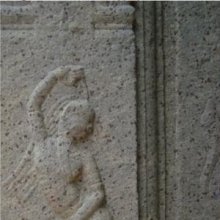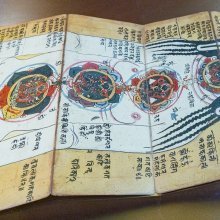Kundalini Yoga, Kunḍalini Yoga: 2 definitions
Introduction:
Kundalini Yoga means something in Hinduism, Sanskrit. If you want to know the exact meaning, history, etymology or English translation of this term then check out the descriptions on this page. Add your comment or reference to a book if you want to contribute to this summary article.
Images (photo gallery)
In Hinduism
Yoga (school of philosophy)
Source: Wisdom Library: YogaKundalini yoga is an ancient practice designed to bring forth the "Kundalini", or reservoir of energy, stored at the base of the spine. Through the use of breath, posture, chanting and meditation, this energy is stimulated and consciously directed through the chakras or energy centers along the spine. Several breathing techniques are emphasized - alternate nostril breathing; slow, diaphragmatic breathing and a dynamic technique called breath of fire.
Kundalini Yoga is a style of Hatha Yoga;

Yoga is originally considered a branch of Hindu philosophy (astika), but both ancient and modern Yoga combine the physical, mental and spiritual. Yoga teaches various physical techniques also known as āsanas (postures), used for various purposes (eg., meditation, contemplation, relaxation).
General definition (in Hinduism)
Source: Hindupedia: The Hindu EncyclopediaIn Kunḍalini yoga, one realizes divine consciousness through the activation of the hidden energy of Kunḍalini. There are six centers (cakras) in the spinal channel. Kunḍalini is said to be initially coiled up at mulādhara. She is the Mother. She passes through these six from mulādhara at the bottom of spine to ajna at the forehead, then to the crown of the head (sahasrāra) where individual consciousness fully unites with cosmic consciousness. There, the Mother is said to unite with the Lord. This involves the opening of three knots or granthis in the path, called Brahma granthi, Viṣṇu granthi and Rudra granthi. There is one granthi per two cakras. Mulādhara (pelvic) and swadhisthāna (navel) associate with Brahma granthi, manipura (heart center) and anāhata (midway between neck and solar plexus) associate with Viṣṇu granthi, visuddha (throat) and ajna (center of forehead) associate with Rudra granthi. These three are the triputi discussed above.
The worship of Śrī-Cakra with nine levels is also a means to this in Śrī-Vidyā. Kunḍalini is said to be completely activated, with the Mother uniting with the Lord at Sahasrāra, when the devotee reaches the bindu of Śrī-Cakra. The union of Mother Kunḍalini with the Lord is the liberation of seeker from Māya. This is possible with anugraha or grace as discussed above, and completes the cycle of births. This is the same as realizing Nada Brahman in mantra yoga, and sāyujya of laya yoga.
See also (Relevant definitions)
Partial matches: Yoga, Kundalini.
Full-text: Siva Tattva.
Relevant text
Search found 4 books and stories containing Kundalini Yoga, Kunḍalini yoga; (plurals include: Kundalini Yogas, Kunḍalini yogas). You can also click to the full overview containing English textual excerpts. Below are direct links for the most relevant articles:
Diaspora of Bhuta (Daiva) worshipping cult—India and Indonesia (by Shilpa V. Sonawane)
Part 6.3 - Association with Tantra < [Chapter 4 - Inter-Disciplinary Analysis]
Part 4 - Agama Hinduism followed by Hindus in Bali Indonesia < [Chapter 4 - Inter-Disciplinary Analysis]
Aspects of Mysticism in “Savitri” < [April – June, 1980]
Dynaneshwari: The Fountainhead of Marathi Literature < [Jan. – Mar. 1991 & Apr. – Jun. 1991]
Bhagavan Ramana and Vasishtha Ganapati Muni < [October - December 1976]
Jainism and Patanjali Yoga (Comparative Study) (by Deepak bagadia)
Part 2 - Patanjali and his Rajayoga < [Chapter 2 - Yoga philosophy and practices]
The Religion and Philosophy of Tevaram (Thevaram) (by M. A. Dorai Rangaswamy)
Chapter 4.6 - (i) Symbology of the serpent and worship < [Volume 2 - Nampi Arurar and Mythology]

